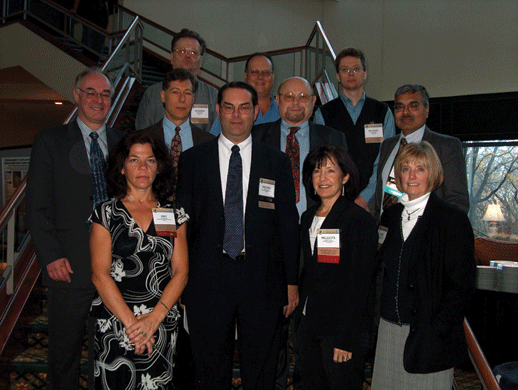Second Symposium on Beryllium Particulates and Their Detection
The Second Symposium on Beryllium Particulates and Their Detection was held in Salt Lake City, Utah, USA, November 8 and 9, 2005.The use of beryllium in industrial settings and consumer products has grown in recent years. Workplace exposure to beryllium at trace levels can result in sensitization and/or disease. In the USA, the American Conference of Governmental Industrial Hygienists (ACGIH) has proposed a reduced threshold limit value (TLV) for beryllium and its compounds. Independently, the USA Occupational Safety and Health Administration (OSHA) is considering a reduction of its permissible exposure level (PEL) for beryllium. As a result, concerns about controlling and measuring beryllium exposure in the workplace have also grown.
New sampling and analysis methods are required to meet the challenge of stricter exposure limits for beryllium. Although the historical focus has been on monitoring the total mass of beryllium particulate in air, interest has grown in measuring particulate on workplace surfaces because of studies suggesting that skin exposure may be a concern. Further, there has also been interest in metrics other than total mass, such as particle size and particle number. There is also a strong interest, particularly within the US Department of Energy (DOE), to develop capabilities for measuring beryllium in the field, rather than relying exclusively on fixed-laboratory analyses.
An initial Symposium on Beryllium Particulates and Their Detection was held in February, 2002, in Santa Fe, NM, USA. This symposium, and events that followed, spawned additional interest in improving capabilities for beryllium sampling and analysis. In early 2005, DOE suggested that another symposium be held to exchange information on recent developments in these areas. Other governmental agencies in the USA were also interested. This interest led to the Second Symposium on Beryllium Particulates and Their Detection, co-sponsored by DOE, the National Institute for Occupational Safety and Health (NIOSH), Savannah River National Laboratory (a DOE laboratory in Aiken, SC, USA), the Rocky Mountain Center for Occupational and Environmental Health (RMCOEH) in Salt Lake City, Eichrom Technologies (Darien, IL, USA), and the Beryllium Health and Safety Committee (BHSC). The BHSC (http://www.sandia.gov/BHSC) is an ad hoc group composed of medical, operations, and support personnel from the USA and the UK. Over 100 individuals from the USA, UK, and Canada, representing a variety of disciplines, took part in the two-day event. The two keynote presentations, along with several others, have been submitted to JEM and are included in this issue. Members of the Symposium Organizing Committee are shown in Fig. 1.
 | ||
| Fig. 1 Members of the Symposium Organizing Committee. Front row (left to right): Amy Ekechukwu, Savannah River National Laboratory; Michael Brisson, Washington Savannah River Company; Melecita Archuleta, Sandia National Laboratory; Connie Crandall, Rocky Mountain Center for Occupational and Environmental Health. Middle row (left to right): Martin Harper, National Institute for Occupational Safety and Health (USA); David Weitzman, US Department of Energy; Steve Edwards, US Occupational Safety and Health Administration; Anoop Agrawal, Berylliant Inc. Back row (left to right): Warren Hendricks, US Occupational Safety and Health Administration; Lawrence Jassin, Eichrom Technologies; Michael Simmons, US Occupational Safety and Health Administration. | ||
The first day of the symposium was devoted to sampling issues. After an overview of beryllium exposure by BHSC Chair Kathryn Creek (Los Alamos National Laboratory), the keynote presentation on inhalable sampling of aerosols was given by Martin Harper of NIOSH. These were followed by seven presentations and a panel discussion on sampling issues facing industrial hygienists. Speakers included David Weitzman (DOE), James Johnson (Lawrence Livermore National Laboratory), Sarah Dufay (Sandia National Laboratory), Gary Whitney (Los Alamos National Laboratory), Elton Hewitt (Fluor Hanford), Thomas Klingner (Colormetric Laboratories), and Joseph Zayed (University of Montreal). An evening reception and poster session concluded the day.
The second day focused on laboratory and field methods and equipment. The keynote presentation discussed the state of the art of trace-level beryllium analysis and associated challenges. This was followed by presentations on analytical innovations, efforts to harmonize analytical methods, and the need for equipment that can provide results in, or near, real-time in a field setting. Speakers included Michael Brisson (Washington Savannah River Company), Daniel McAlister (PG Research Foundation), Stephen Cristy (BWXT Y-12), Lawrence Jassin (Eichrom Technologies), Anoop Agrawal (Berylliant, Inc.), Bernard Phifer (Oak Ridge National Laboratory), Rohit Shah (Lawrence Livermore National Laboratory), and Kevin Ashley (NIOSH). A panel discussion generated lively discussion on improvement opportunities for laboratory and field methods. The day ended with an evening tour of OSHA’s Salt Lake Technical Center.
Twelve exhibitors (Agilent Technologies, Berylliant Inc., Colormetric Laboratories, DataChem Laboratories, Eichrom Technologies, Environmental Express, Nextteq LLC, Perkin-Elmer, Sceptor Industries, SKC, USA Department of Labor, and Whatman) displayed a variety of sampling and analysis equipment, and the organizers thank them for their support.
The BHSC is pursuing establishment of a beryllium oxide reference material to provide a more robust benchmark for validating sample preparation methods. Additional testing of inhalable aerosol sampling equipment is needed. Research and development will continue with an emphasis on field-portable equipment capable of producing results in, or near, real time. Due to the interest and ongoing research in these areas, a Third Symposium on Beryllium Particulates and Their Detection is anticipated at a future date.
Michael J. Brisson
Symposium Chair
Senior Technical Advisor
Washington Savannah River Co.
Aiken, SC 29808, USA
| This journal is © The Royal Society of Chemistry 2006 |
